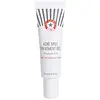What's inside
What's inside
 Key Ingredients
Key Ingredients

 Benefits
Benefits

 Concerns
Concerns

 Ingredients Side-by-side
Ingredients Side-by-side

Water
Skin ConditioningButylene Glycol
HumectantHydroxyethylcellulose
Emulsion StabilisingGlycerin
HumectantPhenoxyethanol
PreservativeSodium Hydroxide
BufferingGlycolic Acid
BufferingUrea
BufferingAloe Barbadensis Leaf Juice
Skin ConditioningBisabolol
MaskingColloidal Oatmeal
AbsorbentMaltodextrin
AbsorbentCarica Papaya Fruit Extract
Skin ConditioningPotassium Sorbate
PreservativeSodium Benzoate
MaskingCamellia Sinensis Leaf Extract
AntimicrobialChrysanthemum Parthenium Extract
Skin ConditioningGlycyrrhiza Glabra Root Extract
BleachingSalix Nigra Bark Extract
Skin ProtectingDisodium Phosphate
BufferingPolysorbate 60
EmulsifyingLeuconostoc/Radish Root Ferment Filtrate
AntimicrobialSodium Phosphate
BufferingCitric Acid
BufferingWater, Butylene Glycol, Hydroxyethylcellulose, Glycerin, Phenoxyethanol, Sodium Hydroxide, Glycolic Acid, Urea, Aloe Barbadensis Leaf Juice, Bisabolol, Colloidal Oatmeal, Maltodextrin, Carica Papaya Fruit Extract, Potassium Sorbate, Sodium Benzoate, Camellia Sinensis Leaf Extract, Chrysanthemum Parthenium Extract, Glycyrrhiza Glabra Root Extract, Salix Nigra Bark Extract, Disodium Phosphate, Polysorbate 60, Leuconostoc/Radish Root Ferment Filtrate, Sodium Phosphate, Citric Acid
Water
Skin ConditioningPropanediol
SolventEthylhexyl Palmitate
EmollientCetearyl Alcohol
EmollientCaprylic/Capric Triglyceride
MaskingGlycerin
HumectantPolysorbate 60
EmulsifyingIsononyl Isononanoate
EmollientDimethicone
EmollientSorbitan Stearate
EmulsifyingHydroxypropyl Cyclodextrin
MaskingGlyceryl Stearate
EmollientPEG-100 Stearate
Laurocapram
Skin ConditioningGalla Rhois Gallnut Extract
AntimicrobialCamphor
MaskingMenthol
MaskingPanthenol
Skin ConditioningNiacinamide
SmoothingCentella Asiatica Extract
CleansingButylene Glycol
HumectantPolyacrylate-13
Hydroxyacetophenone
AntioxidantAcrylates/C10-30 Alkyl Acrylate Crosspolymer
Emulsion StabilisingScutellaria Baicalensis Root Extract
AstringentSalvia Miltiorrhiza Root Extract
Skin ConditioningPaeonia Suffruticosa Root Extract
Skin ProtectingTriethanolamine
BufferingPolyisobutene
Caprylhydroxamic Acid
Xanthan Gum
EmulsifyingDisodium EDTA
Polysorbate 20
EmulsifyingSorbitan Isostearate
EmulsifyingAstragalus Membranaceus Root Extract
EmollientSaposhnikovia Divaricata Root Extract
AntimicrobialCalendula Officinalis Flower Extract
MaskingAlbizia Julibrissin Flower Extract
Skin ConditioningGastrodia Elata Root Extract
Skin ConditioningWater, Propanediol, Ethylhexyl Palmitate, Cetearyl Alcohol, Caprylic/Capric Triglyceride, Glycerin, Polysorbate 60, Isononyl Isononanoate, Dimethicone, Sorbitan Stearate, Hydroxypropyl Cyclodextrin, Glyceryl Stearate, PEG-100 Stearate, Laurocapram, Galla Rhois Gallnut Extract, Camphor, Menthol, Panthenol, Niacinamide, Centella Asiatica Extract, Butylene Glycol, Polyacrylate-13, Hydroxyacetophenone, Acrylates/C10-30 Alkyl Acrylate Crosspolymer, Scutellaria Baicalensis Root Extract, Salvia Miltiorrhiza Root Extract, Paeonia Suffruticosa Root Extract, Triethanolamine, Polyisobutene, Caprylhydroxamic Acid, Xanthan Gum, Disodium EDTA, Polysorbate 20, Sorbitan Isostearate, Astragalus Membranaceus Root Extract, Saposhnikovia Divaricata Root Extract, Calendula Officinalis Flower Extract, Albizia Julibrissin Flower Extract, Gastrodia Elata Root Extract
 Reviews
Reviews

Ingredients Explained
These ingredients are found in both products.
Ingredients higher up in an ingredient list are typically present in a larger amount.
Butylene Glycol (or BG) is used within cosmetic products for a few different reasons:
Overall, Butylene Glycol is a safe and well-rounded ingredient that works well with other ingredients.
Though this ingredient works well with most skin types, some people with sensitive skin may experience a reaction such as allergic rashes, closed comedones, or itchiness.
Learn more about Butylene GlycolGlycerin is already naturally found in your skin. It helps moisturize and protect your skin.
A study from 2016 found glycerin to be more effective as a humectant than AHAs and hyaluronic acid.
As a humectant, it helps the skin stay hydrated by pulling moisture to your skin. The low molecular weight of glycerin allows it to pull moisture into the deeper layers of your skin.
Hydrated skin improves your skin barrier; Your skin barrier helps protect against irritants and bacteria.
Glycerin has also been found to have antimicrobial and antiviral properties. Due to these properties, glycerin is often used in wound and burn treatments.
In cosmetics, glycerin is usually derived from plants such as soybean or palm. However, it can also be sourced from animals, such as tallow or animal fat.
This ingredient is organic, colorless, odorless, and non-toxic.
Glycerin is the name for this ingredient in American English. British English uses Glycerol/Glycerine.
Learn more about GlycerinPolysorbate 60 is used to help stabilize products. It is a surfactant and emulsifier. These properties help keep ingredients together in a product. Surfactants help reduce surface tension between ingredients with different states, such as liquids and solids. Emulsifiers help prevent oils and waters from separating.
Polysorbate 60 is sorbitol-based and created from the ethoxylation of sorbitan. Ethoxylation is a chemical reaction used to add ethylene oxide. Sorbitan is a the dehydrated version of sorbitol, a sugar found in fruits.
In this case, the 60 comes from reacting 60 units of ethylene oxide with sorbitan.
Polysorbates are commonly used in medicine and foods.
Learn more about Polysorbate 60Water. It's the most common cosmetic ingredient of all. You'll usually see it at the top of ingredient lists, meaning that it makes up the largest part of the product.
So why is it so popular? Water most often acts as a solvent - this means that it helps dissolve other ingredients into the formulation.
You'll also recognize water as that liquid we all need to stay alive. If you see this, drink a glass of water. Stay hydrated!
Learn more about Water